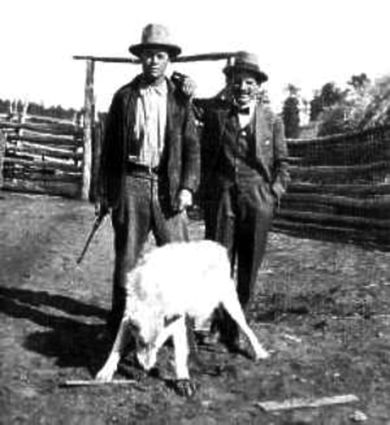"High-Powered" Williams and the Custer Wolf
March 25, 2021

Harry P. Williams, pictured above holding his rifle, is photographed alongside an unidentified man and the carcass of the Custer Wolf, in October of 1920. The photo is from the National Archives and reprinted in Bruce Hampton's The Great American Wolf.
By Shane Dunning
http://www.redshalereflections.com
"The Custer Wolf is Dead."
So began a remarkable press release dated January 17, 1921, by the US Department of Agriculture Press Service. This incredible story was picked up by hundreds of newspapers throughout the country, describing the nearly six-month effort of Harry P. Williams to eliminate perhaps one of the most calculating and vicious livestock killers nature had ever produced.
The USDA's press release entitled "World's Greatest Animal Criminal Dead" did not mince words:
He was the master criminal of the animal world.
Throughout the region around Custer, SD, that day, the telephone lines were busier that they were on the day the Armistice was signed.
For 9 years this wolf had lived as an outlaw-the cruelest, the most sagacious, the most successful animal outlaw that the range country had ever known. His cruelty was surpassed only by his cunning. He killed with the refinement of animal ferocity.
While this press release may seem overly dramatic, it was less so than those of us in more modern times might think. By the time of his death, the Custer Wolf had killed over $25,000 worth of livestock (an astounding amount of money in the 1920s). The massive $500 reward and the efforts of several talented government hunters, along with hundreds of amateurs, failed to bring him down.
Finally, in March 1920, the USDA Biological Survey (forerunner of today's Fish & Wildlife Service) ordered its best hunter, 44-year-old H.P. Williams, to the Black Hills with orders to "stay after the wolf until he was taken, no matter how much time was required." It took Williams more than six months.
Harry Percival Williams was born in Elbert County, Colorado. Already an excellent horseman in his early twenties, he came to Buffalo, Wyoming, around 1900. Williams worked for several area ranches and even had a run-in with Arapahoe Brown, the man who led the attack against the Invaders in the Johnson County War. Another time, while at the Sheridan Inn, he hung a new hat on the rack before entering the dining room. When he exited, he found his hat was gone. The proprietor of the Inn told him, "Tom O'Day has your hat, he's drinking and mean. Don't bother about it, I'll get you another hat." Williams' reply was "you won't get me anther hat." After a brief discussion, the horseman punched O'Day "right from my knees up under the jaw and he went down and out and I picked up my hat, took the gun off him and handed it over to the bar keeper." Williams had no idea Tom O'Day was a notorious member of the Hole-in-the-Wall gang. The two would meet later in a saloon, where the outlaw acknowledged being in the wrong and apologized. "He was a pretty good guy", Williams recalled.
Like many cowboys, Williams spent his winters trapping predators for bounties, and he quickly developed a reputation for being an effective wolfer. By 1920, he was employed by the USDA Biological Survey's Predator Control program. While adept at using traps, his preferred method of killing wolves was shooting them with his Springfield rifle. Indeed, he became so successful at shooting wolves that people started calling him "High Power" Williams, a play on the "H.P." initials he often used instead of "Harry Percival."
The Custer Wolf had already successfully evaded some of the area's most respected hunters. One of them had killed the Custer Wolf's mate and cubs four years before. This act, Williams said, disordered the Custer Wolf's life, making him a loner and extremely unpredictable (thus the term "lone wolf"). He never took another mate, and as his legend grew, people attributed the Wolf's seeming cruelty to a depraved need for revenge.
The Custer Wolf was known to be "trap-wise," eluding tracker's attempts and even springing them purposely, as if in contempt. Actions like this furthered his growing reputation. However, his behavior in his later years drove the public's imagination to extremes. During this time, the Custer Wolf killed far more than what he needed to live. The $25,000 figure mentioned earlier included over 500 domestic animals, and there were reports of him killing several dozen in a single night. Many ranchers gave up trying to kill him and resolved to wait until he died a natural death.
Now, he seemingly enjoyed mutilating animals, including bob-tailing cattle, and directly attacking the sex organs of livestock. Many were left alive only to be put down when their owners found them. The practice that got the populace's imaginations burning was his habit of killing pregnant cows and eating only the unborn calf. The Custer Wolf was now more than an intelligent nuisance; he was a demon with four legs.
It was March of 1920 when H.P. Williams received the telegram from Washington to track this maniac down. The two adversaries jousted with each other for six months. Viewing the wolf with binoculars, Williams saw him "come upon a horse herd. Of course, they spooked all over the area. That wolf rounded them up like a sheep dog would and then had them all bunched up. He sat there and watched them for a minute, then trotted off."
Williams also discovered that his shrewd opponent could evade tracking by climbing a nearby mountain mesa topped with rock. From this vantage, he could then change direction without detection.
By October, Williams discovered that the Custer Wolf had help in the form of two coyotes who followed him everywhere and scavenged on his kills. Traveling 100 to 200 yards on the wolf's flanks, when danger approached, they would run away, and in this manner, warn him. This was unusual behavior for a wolf, who typically kill coyotes when they can. Williams was initially reluctant to shoot the pair for fear of missing a chance to warning his target.
I kept trying and one day saw him with an old carcass, probably an old kill. I eased up on him and was just about in position when those blasted coyotes jumped up again. The wolf took off and this time, though I hated to make the noise, I shot the coyotes.
Because I didn't want him to know what happened, I dumped their bodies in a deep wash and then set some traps around the old carcass. It didn't do any good. He returned the next day, dragged the coyotes up on the rim of the wash, then took the carcass and dragged it over every trap, springing them.
The Custer Wolf was playing with him, and Williams knew it. The wily hunter then used the wolf's curiosity against him.
I took that same old carcass, moved it up the hill a ways and set traps. Sure enough, he moved it back to the original spot and never touched a trap.
Then I scooped up a big pile of dirt beside the carcass, as if another animal was fooling with it. I set a circle of traps out from the carcass – the path I figured he'd follow while looking the situation over.
He put his right forefoot smack in the middle of one. About 150 yards away he jerked the trap against a tree with such force the drag hook snapped loose.
Although his target was free of the trap, he was also now leaving tracks on the top of the rocked mesa. After tracking him for three miles, Williams found and shot him.
He has been so lucky that I expected the gun would fail to shoot, but it worked OK. He is smaller than the average male wolf, weighed about 98 pounds and measured just six feet from tip to tip...He is an old wolf with a fur that is almost white.
The "vicious" and "excessive" habits of the Custer Wolf that terrified the local populace are now understood to be the result of sudden (from an ecological perspective) disruption of the wolf's natural predatory habits. Wolves are highly intelligent, social animals and therefore highly adaptable. The practice of focusing on fresh kills and not returning day upon day to a kill prevented them from falling victim to traps and poison by humans. The practice of "surplus killing" has also been firmly established as a rare but normal behavior in many mammalian predators.









Reader Comments(0)